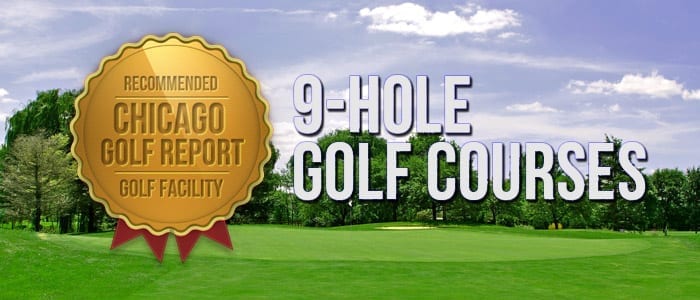
“When you’re short on time, just play nine!”
Realizing the demands and constraints placed upon personal time in modern life, in the early 1970’s some member associations of the USGA accepted 9-hole scores for handicap posting. By the late 1990’s, all associations were required to provide 9-hole ratings so that independent 9-hole scores could be posted to later be combined with another 9-hole score, even if not played consecutively.
 A 9-hole score for posting could come from half of an eighteen hole course, or from one round at a 9-hole course, provided that the 9-holes had a course rating and slope rating. To further encourage 9-hole play, in 2014 the USGA began promoting its ‘PLAY9 initiative’.
A 9-hole score for posting could come from half of an eighteen hole course, or from one round at a 9-hole course, provided that the 9-holes had a course rating and slope rating. To further encourage 9-hole play, in 2014 the USGA began promoting its ‘PLAY9 initiative’.
A tally of all golf courses in the nine counties (Cook, plus 8 surrounding counties in Illinois) of the Chicago metropolitan area, reveals that approximately 15 % are 9-hole courses.
Chicago Golf Report annually publishes a “Top-10” list whose topic is a specific golf characteristic. The topic selected for this year is “9-Hole Golf Courses”.
In order to be considered, a 9-hole course had to be open to the public, and had to be a “stand alone” facility, or, part of a larger golf facility, but where the 9-hole course was not played in combination with other 9-hole routings on the same premises. Also, for our evaluation purposes short par-3 courses were not considered; a course must contain enough holes of sufficient length where drivers were to be used four or more times for tee shots.
Chicago Golf Report analyzed 38 of the area’s 9-hole courses and developed a Top-10 list that every avid golfer in our area should / would enjoy. Factors that were influential in our rankings were: course conditioning, playability, layout, historical significance, amenities, and importance to the surrounding locale.
With all this being said, here is the “Top-10” list of Chicago’s nine-hole courses:
10) HeatherRidge Golf Course (Gurnee); par 35 / 34.7 / 110
Having been opened in 1975, HeatherRidge Golf Course is now in its 46th season of operation. The mature parkland motif is further augmented with flowing creeks and ponds that come into play on seven of the nine holes. The positioning of these creeks and ponds, along with the routing distances require the golf skills of accuracy and length at HeatherRidge.
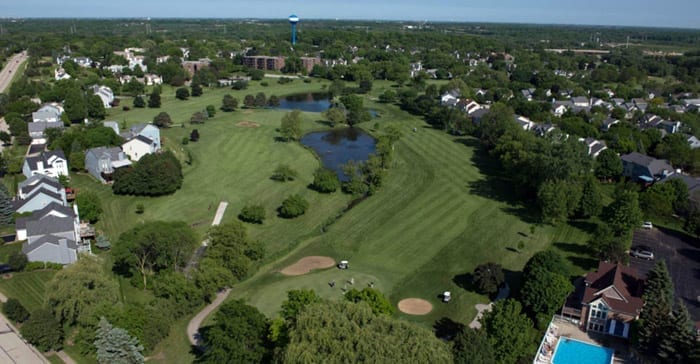
HeatherRidge Golf Club – 8th Hole
Tucked inside the Heather Ridge community, HeatherRidge Golf Course previously had been thought of as a “hidden gem”, but with the help of modern GPS mapping and directions, HeatherRidge GC is now easily located.
9) Willow Hill Golf Course (Northbrook); par 34 / 33.7/ 109
Over the past 100 years the piece of property at 1350 Willow Road in Northbrook has been ‘bookended’ as use for golf courses. Back in the 1920’s the land — very flat, a century ago — was home to Techny Fields Country Club, one of the new private clubs springing up in the northern suburbs. But, by 1930 and the start of the Great Depression, the private club became a daily-fee course open to the public. Finally, after struggling for twenty years, the course closed in 1950.
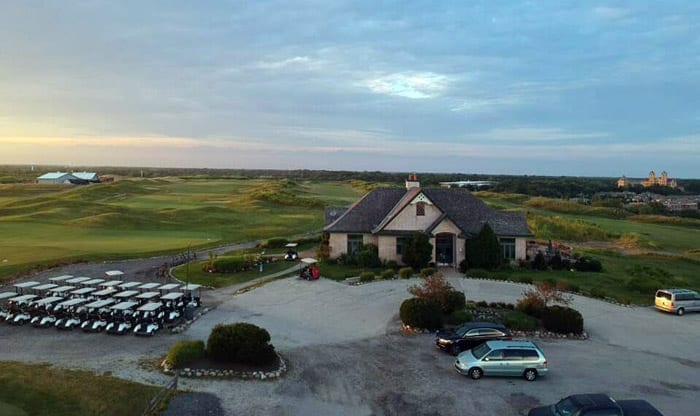
Willow Hill Golf Course
The next use of the property was much less dignified as it became a landfill for the Glenview Disposal Company, which was subsequently absorbed by Waste Management, Inc. Over the next several decades tons of refuse which was brought to the sight created a hill. When the mountain of garbage reached full capacity, it was capped with the necessary clay, dirt, and barriers, and the fine print of the lease for the land mandated that it once again be used as a golf course.
The Nugent family, Dick and Tim, designed the course which opened in 1995. After ‘the dump’ had been transformed into a new golf course, the surrounding area became a desirable location, home to a high end shopping area and $800K houses.
Willow Hill Golf Course is a Scottish links style course, offering amazing views of Chicago’s skyline. The nine holes are set upon an 87-acre facility that includes an on-site pro shop and a 35-station all grass driving range. Rising up 100 feet above normal ground level, there is no need for binoculars or a telescope to experience the great views of the Chicago skyline which are visible from the clubhouse patio and many points on the course itself.
Whatever the season, or be there deluge or drought, the use of tight, erosion resisting turf grass, has produced excellent playing conditions at Willow Hill, where they pride themselves on being an excellent golf facility for all skill levels. Try to plan your round on a calm or less breezy day.
8) Streamwood Oaks Golf Club (Streamwood); par 36 / 36.45 / 125
2020 marks the thirtieth anniversary of this championship 9-hole layout in Streamwood. With a length of 3,404 yards and water in play on all nine of its holes, the course has a rating higher than its par and a slope rating well above the average of 113 — architect Bob Lohmann’s testy gift of golf to the western suburbs. Be prepared for a challenge, but also, be prepared to experience well manicured grounds.
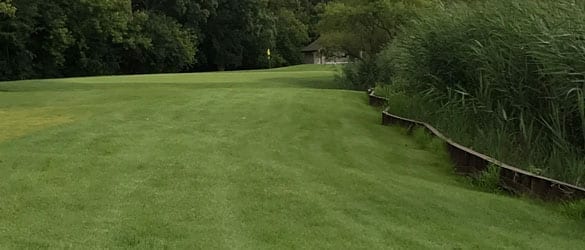
Streamwood Oaks Golf Club – 4th Hole
Lohmann presents a serious mid-round challenge in the trio of holes 4 through 6. Hole #4 stretches 560 yards as a dogleg right with a wetland hazard on its right side. It is followed by the lengthy par-3 measuring 209 yards. And as if all that weren’t enough, there’s the 570 yard par-5, 7th hole. Whether they survive or perish on the mid-round trio, golfers will enjoy the beauty and respite of the short par-3, #8 hole.
The comfortable clubhouse at Streamwood Oaks Golf Club measures 2,400 square feet of space and can accommodate up to 60 people; it is accentuated by tall glass windows on three sides, a central fireplace, and an exterior patio.
7) River Bend Golf Club (Lisle); par 36 / 35.4 / 126
River Bend Golf Club opened in 1993 and just like the battery bunny in the commercial it has been going and going and going…riding high through the golf boom and plowing through the economic downturn, it is a survivor. River Bend Golf Club is a solid and playable layout that is thoroughly cherished by its regular golfers and is immediately pleasing to its newcomers.
The golf course was designed by William J. Spear and with four sets of tees on his layout; the course can be played from distances of 2,600 yards to 3,300 yards. The tees, greens, and fairways are bent grass.
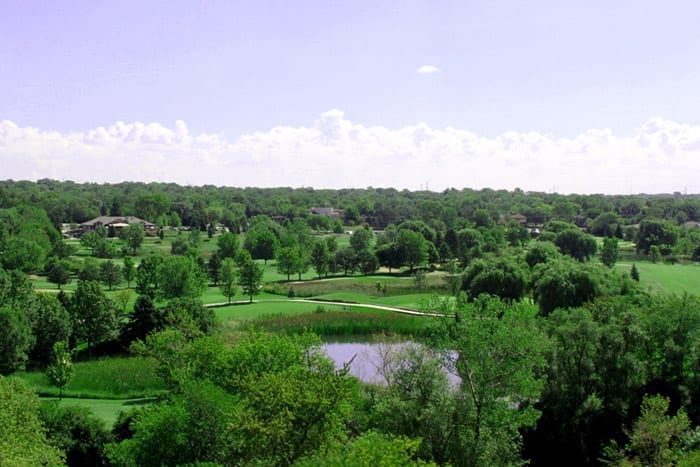
River Bend Golf Club
The placement of hazards, sand and water by architect Spear is very strategic, requiring premium golf club distance control. These trouble spots can often be found from more than one hole. For example, a single bunker can act as a fairway bunker on a dogleg hole and the same bunker happens to be a greenside bunker for a subsequent hole. Although numbering only about 20 on the entire course, Spear’s bunkers are large. Golfers who dread the sand will be in favor of holes #5 and #6 — no bunkers on these holes at River Bend.
Likewise, water hazards are strategically placed; water comes into play on eight of River Bend’s nine holes. Heading for home on his final three holes, Spears has a one-two punch thrown at golfers.
Hole #7 is a tight 533 yard par-5 (hdcp 1) followed by a testy 438 yard par-4 (hdcp 2). After these two ‘tough love’ holes, Spear ends with some ‘true love’ as his finishing hole is a 180 yard par-3.
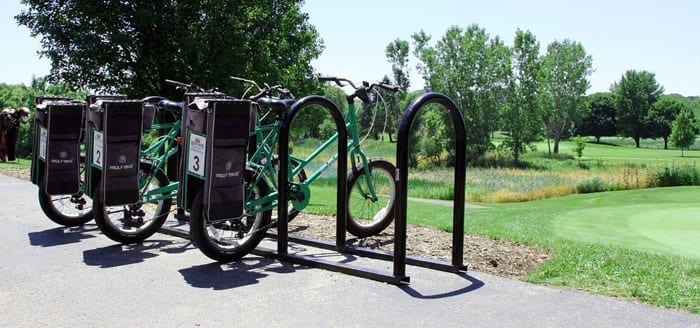
River Bend Golf Course – Golf Bikes
Sometimes referred to as the area’s most innovative course, River Bend offers a unique transportation product, a golf bike (bicycle) — more exercise and eco-friendly.
6) Vernon Hills Golf Course (Vernon Hills); par 34 / 34.5 / 124
Back in 1957 developers Barney Loeb and Quinn Hogan bought 120 acres south of Route 45 and east of Butterfield Road near the small town of Indian Creek for $60,000. They soon began selling pre-fab homes, built a motel, a restaurant, and an 18-hole golf course called Tally Ho Country Club.
Tally Ho CC existed for about twenty years, but ultimately closed with part of the land partitioned and sold as homesites while the remaining land and old Tally Ho CC clubhouse was donated to the established and incorporated Village of Vernon Hills.
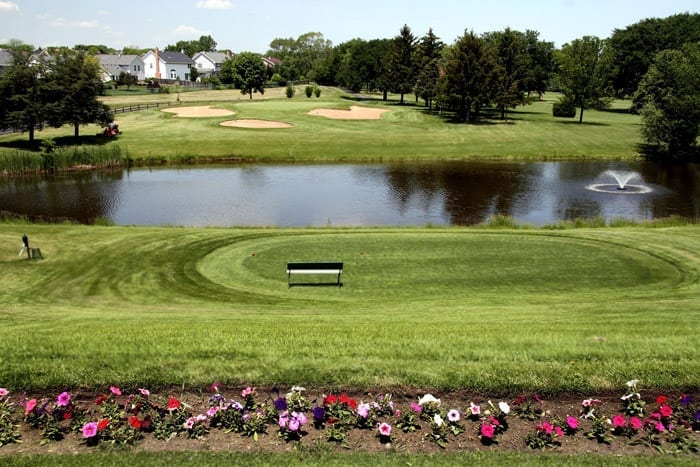
Vernon Hills Golf Course – 7th Hole
Now owned by the village, this remaining land was transformed into the 9-hole Vernon Hills Golf Course. Architect Dick Nugent, with help from Ken Killian, designed Vernon Hills GC and the new course opened to the public in August, 1979. The Vernon Hills GC is managed by KemperSports and features bluegrass fairways with bentgrass greens. The modern full-service clubhouse that opened in the spring of 1995, offers a varied lunch menu served all day and a full-service bar; the practice putting green and swing cage adjacent to the #1 tee allow golfers the opportunity for warm-up before their round.
Two natural features at VHGC are quite noticeable and memorable; these two could be considered the ‘highlight’ and ‘lowlight’ of the course. The highlight is the tee box set atop the 45-foot hill on the par-3, hole#7. The lowlight, both literally and figuratively, is the creek that wanders about the course crossing six fairways. Always strategically positioned, six times, this creek gives poor shots that ‘sinking feeling’ — fear not, the friendly bartender can help drown your sorrows.
5) Flagg Creek Golf Course (Countryside); par 33 / 31.9 / 104
The many years of evolution of Flagg Creek Golf Course has turned this facility into “the area’s total package of 9-hole courses”.
First, a bit about the Flagg Creek history and how it came to be the fine facility that it is today. In the early 1920’s the Robert Henry family developed this property into an 18 hole golf course named Maple Crest. But in the mid 50’s the Illinois Toll Road Authority began construction on the Tri State Tollway reducing the size of the golf course down to just twelve holes — the only 12 hole golf course in the Chicagoland area. The late 80’s brought more changes to the area and there was a push by developers to purchase the golf course and convert it to a condominium/retail development. With community pushback, the property was purchased by the Pleasant Dale Park District and the City of Countryside.
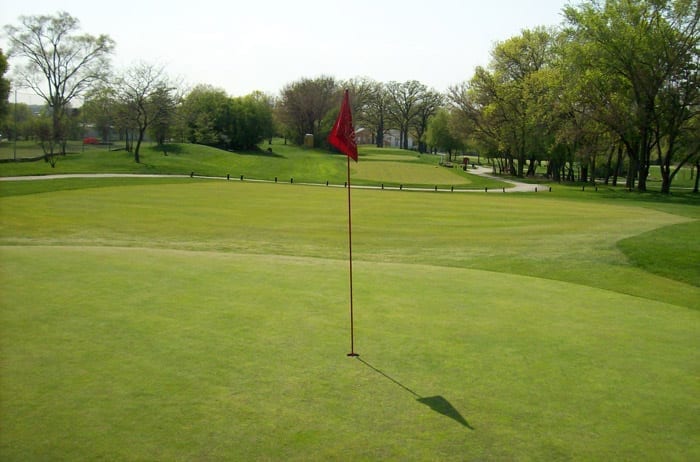
Flagg Creek Golf Course – 6th Hole
Designer Greg Martin plowed under all of Maple Crest’s 12 holes and came up with new 9 hole layout that opened on July 2, 1993. Martin’s design philosophy for the new Flagg Creek was a course that is suitable for players of all levels. There are no forced carries to scare juniors, women and seniors, but there are risks that the low handicapper can take. The course has four par-4s including the 403 yard ninth, four par-3s and the fifth hole a tricky 466 yard par-5.
Flagg Creek’s clubhouse includes the proshop, and bar and grill, which is open daily throughout the golf season and with limited hours during off-season; the walk-out deck affords relaxed outdoor dining. For practice opportunities, Flagg Creek offers an 8,500 square foot putting green and its driving range contains 25 lighted hitting bays with extended hours until 10pm; additionally, Flagg Creek offers 2 short game environments with sand bunkers.
Rest assured that whatever further evolution may be required in order to keep Flagg Creek at full service to its community will be done. Then, now, forever — a total package.
4) Sydney R. Marovitz Golf Course (Chicago); par 36 / 35.5 / 127
Designed by golf course architect Edward B. Dearie, Jr., Waveland Golf Course opened in 1932, and in 1991 was renamed Sydney R. Marovitz Golf Course, honoring the longtime Chicago Park District board member and commissioner emeritus.
‘Location, location, location’ — the credo of real estate agents can be applied to 9-hole golf courses as well, and Marovitz’s single position on the map marvelously fills the threefold desires of location.
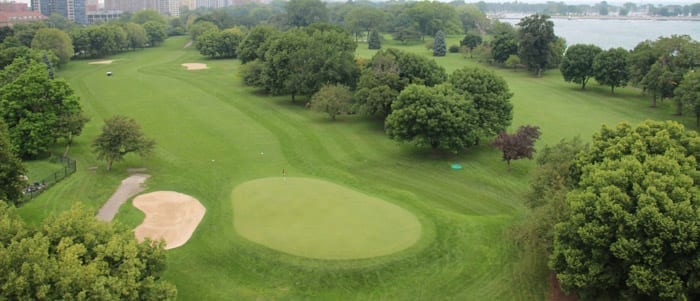
Sydney R. Marovitz Golf Course
First, the Sydney R. Marovitz Golf Course is located well within the city limits of Chicago (population 2.7 million potential golfers). The 9-hole course is situated on prime property on the shore of Lake Michigan in the Lincoln Park neighborhood. And, the course is easily accessible by many means of transportation — Lake Shore Drive for motor traffic, bike paths along the lakefront, and by CTA public bus routes.
Accuracy for drives and approach shots is paramount at Marovitz, as this parkland style layout contains many large, mature trees often flanking both sides of the fairway. And, every green on the course has at least two bunkers that protect the surface on approach shots. On a positive note, all holes run parallel to Lake Michigan, that is north and south, so it is easier to follow the flight of the ball without interference of blinding sunlight. Three sets of tees can accommodate most skill levels.
As a public golf course with heavy demand, pace of play can become an issue.
3) Pottawatomie Golf Course (St. Charles); par 35 / 35.0 / 122
If a person owns a piece of artwork crafted by a master artisan, they then own a masterpiece. Robert Trent Jones, Sr., is a pioneer and master of American golf course design.
Pottawatomie Golf Course in St. Charles was designed by Mr. Robert Trent Jones, Sr. in 1939 and remains to this day a stunning masterpiece of golf course architecture.
According to the chronological listing by the Robert Trent Jones Society, Pottawatomie GC was his first 9-hole design. [Editor’s note: At the same time in 1939 RTJ designed the Norris Estate Golf Course, a 9-hole course that no longer exists].
As the only 9-hole public golf course for the St. Charles community, Pottawatomie Golf Course is a quality course that provides golfing opportunities for all ages and abilities at an affordable price. In addition to the affordable price, golfers at Pottawatomie GC will enjoy the RTJ routing on 42 acres which utilizes the property’s woodlands and the adjacent Fox River to its full extent.
As the country was still experiencing the financial effects of the Great Depression, the land for the golf course was a generous donation to the St. Charles Park District by the Lester J. Norris Family; construction of the course was the final project of Pottawatomie Park’s Works Project Administration (WPA) development project.
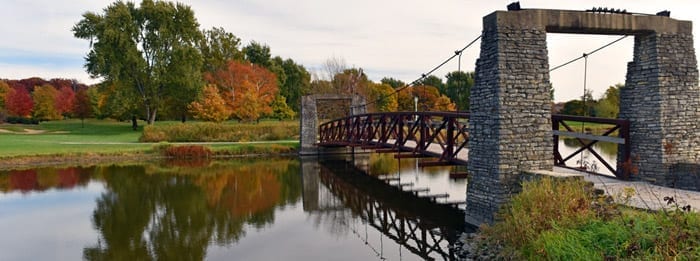
Pottawatomie Golf Course
By 1900 most golf courses worldwide modeled their number of holes after the Old Course at St. Andrews in Scotland, and 18 holes became the norm. Hence, in order to compete in an 18-hole course market, 9-hole Pottawatomie GC throughout it existence had to constantly adopt, adapt, and improve.
In 1976, the St. Charles Park District installed an irrigation system and in 1987, most of Pottawatomie’s greens were re-constructed. From 2000 to 2006, the St. Charles Park District implemented annual upgrades, and up to the present time maintain the grounds to preserve the integrity of the original design.
Pottawatomie’s start is its longest hole, a dogleg 489 yard par-5, but surprisingly, #1 is rated as its easiest hole. Hole #2 (331 yards) is a short-to-moderate length par-4, as are five of the six par-4’s at Pottawatomie. Probably the most memorable feature of this Jones layout is the island green on the dogleg #3 hole. This was RTJ’s very first island green design.
Hole #4 is a short par-3 (154 yards) played alongside the banks of the Fox River. Two moderate length par-4’s follow before reaching the 7th tee and the second crossing of the Fox River — par-3, 197 yards, and two frontal greenside bunkers. A birdie opportunity awaits on the 325 yard par-4 eighth hole. If you have maintained a good score through the first eight holes, you’ll still need your best efforts on RTJ’s finale, 420 yard dogleg par-4 rated as the hardest hole.
In his own words, Mr. Jones is quoted as saying that Pottawatomie had an “exceptionally fine” layout. Quite possibly the most beautiful golf course in the Fox Valley area offering scenic views with lush landscapes along the shore of the Fox River it is no surprise that Pottawatomie hosts 40,000 rounds each year.
2) Belmont Golf Club (Downers Grove); par 36 / 36.2 / 133
One location, several name changes, and a gaggle of golf history. We’re referring to 2420 Haddow Avenue in Downers Grove, the current site of Belmont Golf Club. This location holds a significant place in American golf history as it was this site in 1892 that the original Chicago Golf Club chose to build their 9-hole golf course. Sixty acres of a farm owned by a Scottish immigrant was purchased for $300 and a 9-hole course was quickly constructed. Readied for play in the late spring of 1892, it became America’s first golf course west of the Allegheny mountain range.
When the inaugural season had ended, the Chicago Golf Club members decided to add nine more holes to the course. Therefore, in 1893, the first eighteen- hole golf course in the United States was established on this site. This golf club was also one of the five founding clubs of the United States Golf Association in 1895.
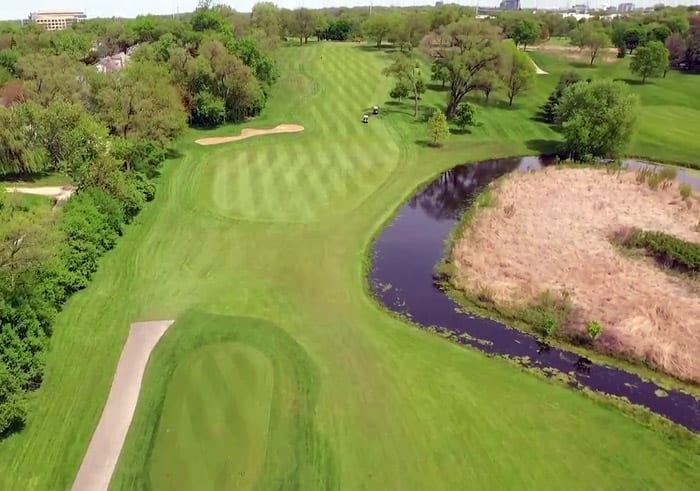
Belmont Golf Club – 3rd Hole
Later in 1895, Chicago Golf Club members had become so taken with the sport that they decided to build a new eighteen-hole golf course on a larger property (two-hundred acres) located in Wheaton, Illinois. After the Chicago Golf Club members moved to Wheaton, the Downers Grove site reverted back to 9 holes.
From 1895 to 1968, the site of the Belmont Golf Club was owned by several different individuals and was operated under the names of The Illinois Golf Club and later the Belmont Country Club. In 1968, the course was purchased by the Downers Grove Park District and was renamed the Downers Grove Golf Course.
Today’s Belmont Golf Club is a parkland style course with two ponds and one curvy creek. Mature trees, some native grass areas, and gradual elevation rises are its other features. The course plays to par 36 with two par-3’s, five par-4’s, and two par-5’s. Right from the git-go golfers must be on their ‘A’ game at DGGC because three of the four toughest holes confront players at the start. Perhaps underrated (as men’s Hdcp 8) is hole #5, a par-4 dogleg left, with wetlands to the right, and fairway bunkers and trees at the left corner. A short, but narrow, par-5 finishing hole offers the chance for par or better with well placed shots.
A driving range with 24 permanent and turf hitting stations, a large practice putting green, sand trap and chipping area are available for pre-round warm up or practice sessions.
Walk the same grounds where America’s golfing ancestors first walked.
1) Tam O’Shanter Golf Course (Niles); par 33 / 31.6 / 106
Tam O’Shanter Golf Course in Niles is the remainder of an older, larger course, which along with its owner George S. May, had more influence in shaping the future of golf tournaments, golf viewing, golf in general in Chicago than any other course in our area.
Tam O’Shanter Country Club was designed in 1925 by C.D. Wagstaff; it was a private club. Unfortunately, in 1936, a fire destroyed the clubhouse of the Tam O’Shanter CC and bankrupted the owners. Stepping in that year, George S. May acquired a controlling interest in the golf club and over the next several years invested more than $500,000 to renovate and operate the facility.
A self-made entrepreneur, in 1941 May became involved in sponsoring golf tournaments. Dissatisfied with his experience attending the 1940 U.S. Open held at Cleveland’s Canterbury Country Club, May shocked the golf world by announcing he would sponsor a new tournament in 1941, the Tam O’Shanter Open, offering the largest purse in professional golf: $15,000.
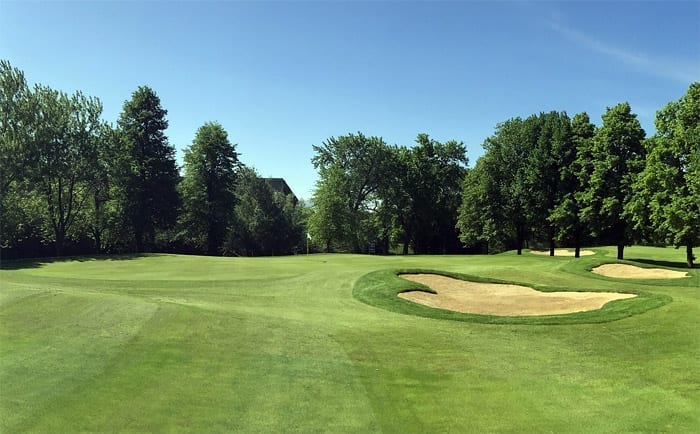
Tam O’Shanter Golf Course – 6th Hole
Investor and innovator, May is responsible for many of today’s golf viewing experiences: May was first to provide grandstands at key locations; May sent shortwave radio broadcasts out to fans; and May’s 1953 World Championship of Golf was the first live professional golf tournament to be broadcast nationwide. The United States Golf Association followed May’s lead in 1954 with the first nationwide broadcast of the U.S. Open, and the Augusta National Golf Club first broadcast the Masters Tournament live in 1956.
George S. May died of a heart attack while at his beloved Tam O’Shanter club on March 12, 1962; the club continued to operate until it was purchased by a developer in the early 1970s. It was in 1973 that Niles Park District obtained the nine-hole portion of the course and reopened the course in 1974, with William J. Spear as architect.
The North Branch of the Chicago River flows through Tam Golf Course, and excessive downpours have caused occasional flooding issues at Tam. In 2018 the course underwent a renovation project completed by Lohmann Quitno Golf Course Architects and Wadsworth Golf Construction Company thus minimizing flooding problems and creating superb playing conditions.
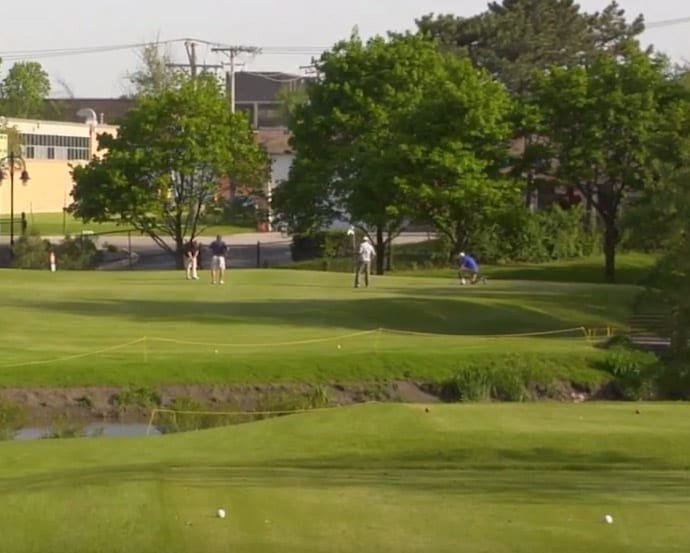
Tam O’Shanter Golf Course – 9th Hole
There are presently six par-4’s and three par-3’s at Tam and today’s layout allows the golfers to attempt to recreate two of golf’s historical shots. Hole #15 from the original layout was a 500-515 yard par-5, located alongside of Caldwell Avenue. The same green is used today as the target for the 159 yard par-3 fifth hole.
Byron Nelson, partially blocked by a hardwood tree, hit an intentional sweeping hook with a 5-wood, that started out over Caldwell Avenue, but was brought back to the 15th green to set up an easy birdie. And today’s #9 green, which once was the #18 green, was the site of the “shot heard ’round the world” (and seen all around the country) as Lew Worsham holed out from 104 yards for an eagle on the final hole of competition to win by a single stroke. Giving golfers the opportunity to become a present day Worsham, setting up as a 108 yard par-3, hole #9 requires tee shots to carry the same portion of the North Branch of the Chicago River as did the famous shot from 1953.
View Tam’s history with historical film footage on their website. Create your own golf history by playing Tam at 6700 W. Howard St., Niles, IL 60714.
Honorable Mention
Finally, in our Honorable Mention category are two 9-hole courses that, except for circumstances, would have been included in this Top-10 list. The Eagle Ridge Resort & Spa’s East Course (Galena) with its unique features is a top pick but is located beyond the nine county Chicago Metropolitan Area. And, Heritage Oaks Golf Club East Nine (Northbrook) was recently remodeled by the Northbrook Park District Board of Commissioners, who allocated $12.5 million for the project.























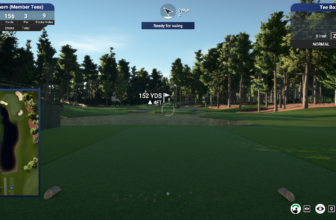
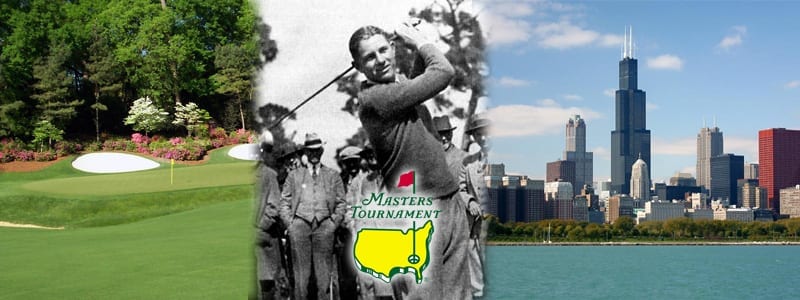
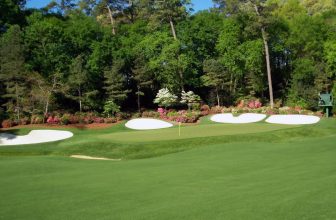

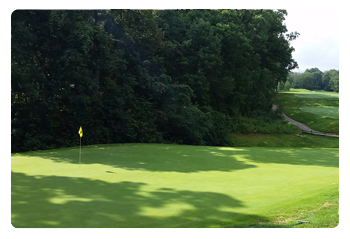 Find a Golf Course
Find a Golf Course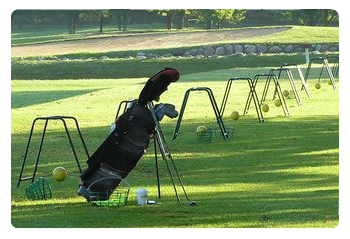 Find a Driving Range
Find a Driving Range Find a Topgolf
Find a Topgolf Find a Golf Instructor
Find a Golf Instructor